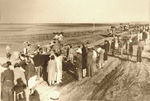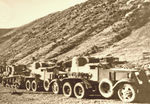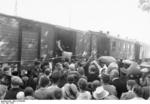Soviet Demands on Romania and the Second Vienna Arbitration
Contributor: C. Peter Chen
ww2dbaseAfter WW1, the Treaty of Trianon of 1920 forced Hungary, a successor state to the defeated Austro-Hungarian Empire, to cede territory to Czechoslovakia. The First Vienna Award of 2 Nov 1938, arbitrated by Germany and Italy, forced Czechoslovakia to return an area 11,927 square kilometers in size to Hungary, and Hungary was only temporarily satisfied in terms of regaining former territory of Hungarian influence.
ww2dbaseOn 23 Jun 1940, the Soviet Union indicated to Germany that it was about to demand Bessarabia and Bukovina from Romania, which greatly alarmed Germany as the German military was dependent on Romania for oil and fodder. The Soviet ultimatum was issued to Romania on 26 Jun. While the Germans noted Bukovina was not included in the Soviet sphere of influence per the Molotov-Ribbentrop Pact of 1939, Germany chose not to contest the Soviet demands, instead advising Romania to concede to prevent giving the Soviet Union a reason to occupy the entire country.
ww2dbaseSeeing this as a sign of weakness on the part of Romania, Hungary made a further demand for Transylvania in Aug 1940. Romania rejected the demand during the negotiation of 16 Aug, and offered only a small region for Hungarian consideration. After the first negotiation attempt failed, they turned to Germany and Italy for arbitration. On 30 Aug 1940, Italian Foreign Minister Galeazzo Ciano and German Foreign Minister Joachim von Ribbentrop presided over the Second Vienna Arbitration at Belvedere Palace in Vienna, Austria. Once again, Germany and Italy ruled in favor of Hungary, awarding it 43,104 square kilometers of territory (Northern Transylvania, Maramures, and part of Crisana). Romania was given 14 days to evacuate the territory. The result was the arbitration was known as the Second Vienna Award.
ww2dbaseOn 5 Sep 1940, Hungarian troops crossed the borders and occupied the territory; Hungarian Regent Miklós Horthy was also among the first to arrive. The occupation completed on 13 Sep. Hungarian troops were accused of murdering many Romanians during the initial occupation period.
ww2dbaseIn order to further secure the Romanian resources that Germany was dependent upon, a German military mission was set up in the Romanian capital of Bucharest; ostensibly to help train the Romanian military, this mission was actually set up to safeguard the Romanian oil fields and to deter further Soviet infringement of Romanian territory.
ww2dbaseAfter the war, the Allies declared both the First and Second Vienna Awards null and void, and the territories lost by Romania were returned; article 19 of the Armistice Agreement with Romania of 12 Sep 1944 specifically noted so.
ww2dbaseSources:
William Shirer, The Rise and Fall of the Third Reich
Wikipedia
Last Major Update: Oct 2010
Photographs
 |  |  |  |
Soviet Demands on Romania and the Second Vienna Arbitration Timeline
| 23 Jun 1940 | Soviet Foreign Minister Vyacheslav Molotov sent German Ambassador Friedrich Werner von der Schulenburg a message noting that the Soviet Union would like to gain Bessarabia and Bukovina from Romania. This greatly alarmed the German OKW as the German military was dependent on Romania as a source of oil and fodder. |
| 26 Jun 1940 | Soviet Union presented an ultimatum demanding territory in Bessarabia and Northern Bukovina from Romania. Adolf Hitler suggested the Romanians government to give in and satisfy the Soviet demands as Hitler was fearful that Romanian resistance might lead to a Soviet occupation of the entire Romania, which would threaten the oil and fodder that the German military was dependent upon. |
| 27 Jun 1940 | Romania ceded Bessarabia and Northern Bukovina to the Soviet Union. |
| 28 Jun 1940 | Soviet Union occupied Bessarabia and the Northern Bukovina, ceded by Romania. |
| 16 Aug 1940 | Hungary and Romania began negotiating over Transylvania, which Hungary wished to take over from Romania. The negotiation soon turned into a deadlock. |
| 28 Aug 1940 | Adolf Hitler ordered troops to prepare for an occupation of Romania should war break out in that country. |
| 29 Aug 1940 | Ribbentrop and Count Ciano met Romanian and Hungarian Ministers in Vienna, Austria. |
| 30 Aug 1940 | In exchange for a German guarantee of security, Romania ceded the region of Dobrudja to Bulgaria and ceded Transylvania to Hungary. This move was forced on Romania by Hitler in an effort to prevent a possible war between Romania and Hungary. |
| 1 Sep 1940 | Vyacheslav Molotov complained that the Second Vienna Arbitration was in violation of the Molotov-Ribbentrop Pact signed in 1939. |
| 3 Sep 1940 | Joachim von Ribbentrop denied that the Second Vienna Arbitration had violated any terms of the Molotov-Ribbentrop Pact, as Vyacheslav Molotov had accused. Furthermore, Ribbentrop complained that the manner in which the Soviet Union had take over the Baltic States was in itself a violation of the pact. |
| 5 Sep 1940 | Hungarian troops entered Northern Transylvania, territory that German and Italy forced Romania to cede to Hungary. |
| 12 Sep 1940 | Hungary completed the occupation of Northern Transylvania, Maramures, and part of Crisana; these were territory Germany and Italy forced Romania to cede. Meanwhile, the Germans established a military mission in Bucharest, ostensibly to train the Romanian Army, but the intended goal was to safeguard the Romanian oil fields. |
| 9 Oct 1940 | German troops began to secure oil fields in Romania, which was vital for the German war effort. |
| 12 Oct 1940 | A new German military mission was set up in Bucharest, Romania to direct the training program for the Romanian Army. |
Did you enjoy this article or find this article helpful? If so, please consider supporting us on Patreon. Even $1 per month will go a long way! Thank you. Share this article with your friends: Stay updated with WW2DB: |
» Ciano, Galeazzo
» Molotov, Vyacheslav
» Ribbentrop, Joachim
Locations:
» Austria
» Moldova
» Romania
» Ukraine
Related Book:
» The Rise and Fall of the Third Reich
 |
- » 1,150 biographies
- » 337 events
- » 43,917 timeline entries
- » 1,241 ships
- » 350 aircraft models
- » 207 vehicle models
- » 375 weapon models
- » 123 historical documents
- » 260 facilities
- » 470 book reviews
- » 28,545 photos
- » 432 maps
Fleet Admiral Chester W. Nimitz, 16 Mar 1945
Please consider supporting us on Patreon. Even $1 a month will go a long way. Thank you!
Or, please support us by purchasing some WW2DB merchandise at TeeSpring, Thank you!